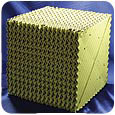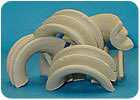RTOs: The Media Matters
Regenerative thermal oxidizers (RTOs) and other types of thermal oxidation systems have proven to be a highly effective and energy-efficient method of abating volatile organic compounds (VOCs) and other pollutants emitted by finishing industry applications. However, careful attention should be given to selecting the shape and material of the heat exchange media to mitigate potential problems with particulate matter and to ensure reliable, economical and safe operation of these systems.

Regenerative thermal oxidizers (RTOs) and other types of thermal oxidation systems have proven to be a highly effective and energy-efficient method of abating volatile organic compounds (VOCs) and other pollutants emitted by finishing industry applications. However, particulate matter in the emission stream can be a particularly vexing problem, resulting in the fouling and plugging of media beds. Careful attention should be given to selecting the shape and material of the heat exchange media to mitigate potential problems with particulate matter and to ensure reliable, economical and safe operation of thermal oxidation systems.
Regenerative thermal oxidizers minimize fuel consumption by “regenerating” or reusing heat generated by the system. Fans draw air from paint-booth collection systems and other sources, and the air is preheated by heat exchanger media to the thermal oxidation temperature, typically 1,400 to 1,600°F (760 to 871°C). The air then moves into a combustion chamber for the specified residence time (0.5 to 2.0 seconds), where an exothermic reaction takes place, converting the VOCs to carbon dioxide and water vapor. Prior to being exhausted to the atmosphere, the hot, purified air passes through a media bed to capture heat energy that will be used to preheat incoming air. Valves continually alternate the flow between media beds: a cycle with incoming cool air into a media bed that has just been heated by hot exhaust, followed by a cycle with hot exhaust air flowing through the media bed to reheat it.
RTOs can operate at thermal efficiencies of 85 to 99%, reducing or eliminating the need to burn natural gas in the combustion chamber. RTOs are particularly effective for process streams with low to moderate solvent loading, as typically found in many finishing industry applications. In fact, RTOs can be self-sustaining at moderate lower explosive limit (LEL) levels. In other words, once the system is sufficiently heated, the natural gas burners can be turned off if enough flammable gas is present in the exhaust stream.
For exhaust streams with high LEL levels (depending on the particular mix of solvents in the application), a simple thermal oxidizer can be used without any thermal regeneration capability. In such cases, a high solvent loading can support combustion without preheating and often with very little or no burning of natural gas.
For air streams with relatively low VOC concentrations, rotary adsorbers can be used to concentrate the stream and increase the LEL level to enable the use of an oxidation device that is smaller and/or more energy efficient. The pollutant-laden process exhaust passes through the rotary adsorption unit, where the VOCs are adsorbed on zeolite or activated carbon media. The purified air is exhausted to the atmosphere, and the solvent is then removed from the media by desorption with a smaller stream of hot air, which is then delivered to an oxidation device.
Finishing materials and methods generate many types of particulate matter. Paint atomizers, for example, create a mist of fine particles, and a percentage of these paint solids inevitably pass through to the RTO, despite any and all attempts to arrest and filter them. The three basic methods of capturing paint overspray - cascade (water wash), baffle and media filtration - operate under the default requirement of 95% arrestance efficiency, and many perform better. Unfortunately, a few percentage points difference can add up to hundreds or thousands of pounds of fugitive particulate passing through the RTO media bed annually.
Other methods of upstream particulate removal methods, including wet and dry electrostatic precipitators (ESP) and cyclone dust collectors, can reduce - but not eliminate - particulate matter entering the RTO.
A portion of the particulate that enters the RTO will collect on the cold face of the media bed. Depending on the design of the media, the particulate buildup can rapidly lead to plugging of the media bed. Plugging causes several significant problems. Blocking airflow results in a rise in pressure drop, forcing the induced draft fan to work harder and consume more electricity. The capacity of the RTO is reduced as the media bed becomes less effective at transferring heat because “dead zones” mean reduced surface area exposed to the air stream and less media mass available to retain heat energy. Moreover, particulate buildup presents a serious fire hazard.
The only remediation solution for these symptoms is a wash-out or bake-out of the media bed, processes that involve costly downtime. Over time, the frequency of wash-out and bake-out procedures typically increase until the only viable solution is a complete media change out.

Random Packing. Originally, in the 1970s, a wide variety of random packing materials were employed in RTOs, including gravel, ceramic balls and shapes of all kinds. The packing material was randomly dumped into the RTO to form a media bed. Random arrangement was preferred in order to prevent nesting that would constrict flow and cause dead areas that collect particulate.
In the 1980s, RTO manufacturers and owners discovered that the ceramic “saddles” developed for chemical mass transfer operations provided an optimal shape for RTO random packing. Relative to other types of random packing, the saddle shape minimized pressure drop (for lower electricity consumption by the induction fan) and maximized surface area (for higher heat transfer efficiency).
Over the years, RTO media suppliers have refined the design of ceramic saddles. For example, one low pressure drop (LPD) random packing design provides a high open area and aerodynamic design that limits nesting and reduces pressure drop by 20% or more compared to standard saddle media.
Several manufacturers coat or impregnate this LPD saddle with a metal catalyst for use in RCOs. Special ceramic compositions such as a glaze-resistant alumina can resist exposure to alkaline chemical attack, which might result from cleaning chemical fumes or the metallic salts used in electroplating applications.
Monolith Structured Block. Another alternative for clean, low-particulate streams is a cordierite ceramic honeycomb monolith. Monolith block is a form of structured packing that is placed in a formal arrangement, rather than randomly dumped. Cells extend through the block in a straight channel perpendicular to the cold face. The advantage of this design is that it theoretically provides a straight, aerodynamic channel for the air stream. The disadvantage is that if particulate plugs a channel at the cold face, where the inflow enters the block, then this entire channel becomes a dead zone.
Corrugated Structured Packing. The most advanced ceramic heat exchange media for RTOs is corrugated structured packing, which is constructed of corrugated sheets of ceramic. The angle of inclination of the corrugations of adjacent sheets is reversed, ensuring excellent distribution of airflow throughout the media bed. Even if an area of the media bed becomes plugged by particulate, the mixing and spreading effect of the alternating corrugation prevents dead zones above the plugged area.
Field studies have shown that RTOs with corrugated structured packing consume the same amount of natural gas as RTOs with monolith structured block, although the former has superior airflow distribution, and the latter has slightly higher heat storage capacity. The advantage of the corrugated solution becomes dramatic over time because of its improved ability to resist fouling caused by particulate buildup.

Ceramic structured packing, such as the FLEXERAMIC® media from Koch Knight LLC, shown above, is constructed of corrugated sheets of ceramic that provide excellent distribution of airflow throughout the media bed and resist fouling caused by particulate buildup.
Regenerative thermal oxidizers (RTOs) and other types of thermal oxidation systems have proven to be a highly effective and energy-efficient method of abating volatile organic compounds (VOCs) and other pollutants emitted by finishing industry applications. However, particulate matter in the emission stream can be a particularly vexing problem, resulting in the fouling and plugging of media beds. Careful attention should be given to selecting the shape and material of the heat exchange media to mitigate potential problems with particulate matter and to ensure reliable, economical and safe operation of thermal oxidation systems.
Regenerative Thermal Oxidation
Thermal oxidizers are essentially incinerators that thermally or catalytically convert pollutant-laden emissions into carbon dioxide and water vapor. The oxidation process typically achieves better than 99% destruction/removal efficiency (DRE) levels for VOCs, hazardous air pollutants (HAPs) and odors.Regenerative thermal oxidizers minimize fuel consumption by “regenerating” or reusing heat generated by the system. Fans draw air from paint-booth collection systems and other sources, and the air is preheated by heat exchanger media to the thermal oxidation temperature, typically 1,400 to 1,600°F (760 to 871°C). The air then moves into a combustion chamber for the specified residence time (0.5 to 2.0 seconds), where an exothermic reaction takes place, converting the VOCs to carbon dioxide and water vapor. Prior to being exhausted to the atmosphere, the hot, purified air passes through a media bed to capture heat energy that will be used to preheat incoming air. Valves continually alternate the flow between media beds: a cycle with incoming cool air into a media bed that has just been heated by hot exhaust, followed by a cycle with hot exhaust air flowing through the media bed to reheat it.
RTOs can operate at thermal efficiencies of 85 to 99%, reducing or eliminating the need to burn natural gas in the combustion chamber. RTOs are particularly effective for process streams with low to moderate solvent loading, as typically found in many finishing industry applications. In fact, RTOs can be self-sustaining at moderate lower explosive limit (LEL) levels. In other words, once the system is sufficiently heated, the natural gas burners can be turned off if enough flammable gas is present in the exhaust stream.
Other Thermal Oxidizers
For solvent loading levels below 4% LEL, a catalytic system is often recommended. A regenerative catalytic oxidizer (RCO) has a similar design to an RTO, except that the ceramic heat exchange media closest to the combustion zone is coated or impregnated with precious metals. The precious metals function as a catalyst that enables oxidation at significantly lower temperatures (600 to 1,000°F [315 to 538°C]). A catalytic system requires the presence of the type of VOCs that will oxidize at these lower temperatures, including acetones, methanol, ketones and other solvents used in finishing processes. RCOs use the same principle as catalytic converters in motor vehicles that oxidize carbon monoxide and unburned hydrocarbons to carbon dioxide and water.For exhaust streams with high LEL levels (depending on the particular mix of solvents in the application), a simple thermal oxidizer can be used without any thermal regeneration capability. In such cases, a high solvent loading can support combustion without preheating and often with very little or no burning of natural gas.
For air streams with relatively low VOC concentrations, rotary adsorbers can be used to concentrate the stream and increase the LEL level to enable the use of an oxidation device that is smaller and/or more energy efficient. The pollutant-laden process exhaust passes through the rotary adsorption unit, where the VOCs are adsorbed on zeolite or activated carbon media. The purified air is exhausted to the atmosphere, and the solvent is then removed from the media by desorption with a smaller stream of hot air, which is then delivered to an oxidation device.
Upstream Particulate Removal
Although oxidizer systems are used primarily for the abatement of VOCs, all emission streams contain some quantity of particulate matter. These particles can lead to bed fouling, performance degradation and even to dangerous and destructive fires.Finishing materials and methods generate many types of particulate matter. Paint atomizers, for example, create a mist of fine particles, and a percentage of these paint solids inevitably pass through to the RTO, despite any and all attempts to arrest and filter them. The three basic methods of capturing paint overspray - cascade (water wash), baffle and media filtration - operate under the default requirement of 95% arrestance efficiency, and many perform better. Unfortunately, a few percentage points difference can add up to hundreds or thousands of pounds of fugitive particulate passing through the RTO media bed annually.
Other methods of upstream particulate removal methods, including wet and dry electrostatic precipitators (ESP) and cyclone dust collectors, can reduce - but not eliminate - particulate matter entering the RTO.
Impact of Particulate Buildup
Particulate that penetrates deeper into the media bed will tend to burn off. However, chemically reactive particles can cause problems even when they penetrate deep into the media. For example, alkaline particles, such as chromium used in electroplating, can react with ceramic media at high temperatures to cause embrittlement, crumbling and bed plugging.A portion of the particulate that enters the RTO will collect on the cold face of the media bed. Depending on the design of the media, the particulate buildup can rapidly lead to plugging of the media bed. Plugging causes several significant problems. Blocking airflow results in a rise in pressure drop, forcing the induced draft fan to work harder and consume more electricity. The capacity of the RTO is reduced as the media bed becomes less effective at transferring heat because “dead zones” mean reduced surface area exposed to the air stream and less media mass available to retain heat energy. Moreover, particulate buildup presents a serious fire hazard.
The only remediation solution for these symptoms is a wash-out or bake-out of the media bed, processes that involve costly downtime. Over time, the frequency of wash-out and bake-out procedures typically increase until the only viable solution is a complete media change out.

A low-pressure-drop random packing design, such as the FLEXISADDLE® LPD® media from Koch Knight LLC, shown above, can limit nesting and reduce pressure drop by 20% or more compared to standard RTO saddle media.
Types of Media
Over the past few decades, several different types of heat transfer media have been used for RTOs. Three main categories are random packing, monolithic structured block and corrugated structure packing.Random Packing. Originally, in the 1970s, a wide variety of random packing materials were employed in RTOs, including gravel, ceramic balls and shapes of all kinds. The packing material was randomly dumped into the RTO to form a media bed. Random arrangement was preferred in order to prevent nesting that would constrict flow and cause dead areas that collect particulate.
In the 1980s, RTO manufacturers and owners discovered that the ceramic “saddles” developed for chemical mass transfer operations provided an optimal shape for RTO random packing. Relative to other types of random packing, the saddle shape minimized pressure drop (for lower electricity consumption by the induction fan) and maximized surface area (for higher heat transfer efficiency).
Over the years, RTO media suppliers have refined the design of ceramic saddles. For example, one low pressure drop (LPD) random packing design provides a high open area and aerodynamic design that limits nesting and reduces pressure drop by 20% or more compared to standard saddle media.
Several manufacturers coat or impregnate this LPD saddle with a metal catalyst for use in RCOs. Special ceramic compositions such as a glaze-resistant alumina can resist exposure to alkaline chemical attack, which might result from cleaning chemical fumes or the metallic salts used in electroplating applications.
Monolith Structured Block. Another alternative for clean, low-particulate streams is a cordierite ceramic honeycomb monolith. Monolith block is a form of structured packing that is placed in a formal arrangement, rather than randomly dumped. Cells extend through the block in a straight channel perpendicular to the cold face. The advantage of this design is that it theoretically provides a straight, aerodynamic channel for the air stream. The disadvantage is that if particulate plugs a channel at the cold face, where the inflow enters the block, then this entire channel becomes a dead zone.
Corrugated Structured Packing. The most advanced ceramic heat exchange media for RTOs is corrugated structured packing, which is constructed of corrugated sheets of ceramic. The angle of inclination of the corrugations of adjacent sheets is reversed, ensuring excellent distribution of airflow throughout the media bed. Even if an area of the media bed becomes plugged by particulate, the mixing and spreading effect of the alternating corrugation prevents dead zones above the plugged area.
Field studies have shown that RTOs with corrugated structured packing consume the same amount of natural gas as RTOs with monolith structured block, although the former has superior airflow distribution, and the latter has slightly higher heat storage capacity. The advantage of the corrugated solution becomes dramatic over time because of its improved ability to resist fouling caused by particulate buildup.
Lifetime Cost of Operation
Owners of thermal oxidizers have a number of options available when installing a new system or replacing the media bed of an existing system. For VOC abatement systems in the finishing industry, where particulates can be a concern, corrugated structured packing should be considered. This advanced solution might cost more to purchase and install, but it will provide lower pressure drop, higher heat transfer efficiency, more reliable operation and a longer useful life compared to the alternative media. The significant long-term reduction in energy consumption alone can far outweigh the additional cost of installing advanced heat exchange media.Links
Looking for a reprint of this article?
From high-res PDFs to custom plaques, order your copy today!





